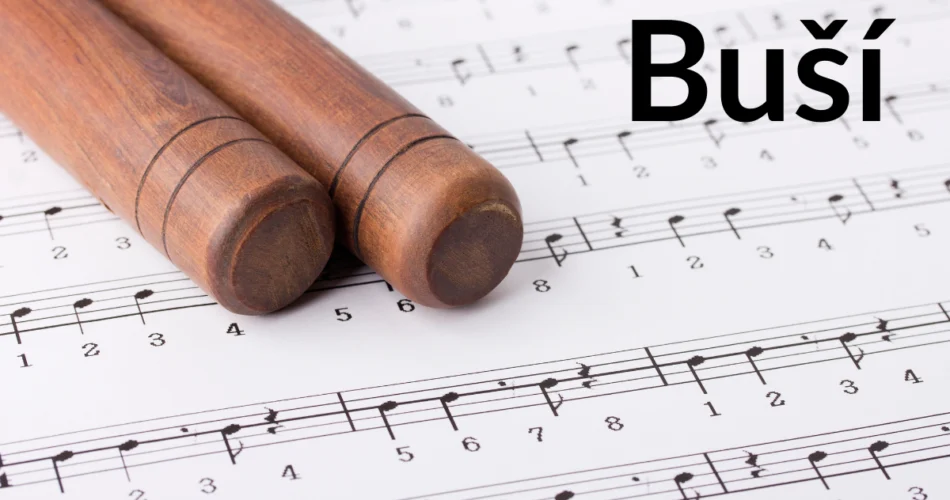You are cordially invited, esteemed readers, to a pulsating excursion into the enthralling universe of Buší! It is an exceptional cultural phenomenon that will captivate you with its distinctive charm and reveal its rich history, customs, and creative manifestations. We will study the history of this rhythmic paradise and its adaptations to current times, looking at how it has changed physically and figuratively. As we go off on an exciting journey to discover the rhythmic beauty of this, make sure to bring your drumsticks!
Table of Contents
What is Buší?
Buší is a compelling and lively traditional percussion music style that originated in the lovely Czech Republic. Rhythms and beats passed down through the centuries give it its distinctive flavor. Using drums and other percussion instruments to produce a throbbing symphony of sound is the central focus of it.
An essential component of Czech identity, this rhythmic art form has profound cultural importance. From coast to coast, it’s a way for people to express themselves, share joy, and celebrate. In any social or celebratory setting, it unites people harmoniously.
The harmony it creates between artists and listeners is just as lovely as the music itself. The stories spoken by each beat transcend language borders and unite people fundamentally. These stories might be about pleasure, love, success, or even tragedy.
The core of it is a pulsating beat encompassing the values of community, creativity, and joy. Please take a minute to immerse yourself in the wonderful sounds the next time you hear them resonating off old walls or gliding across the airwaves.
The History and Origins
The tradition-rich history of Buší, a rhythmic and mesmerizing dance style that has captivated centuries, is extensive. It all started in ancient times when people would gather for religious celebrations or commemorate special occasions. The precise origins of this are unknown; however, its influence is said to have extended many centuries.
This developed as a way for communities to show joy and solidarity, passed down through generations through oral traditions and physical gestures. Beyond its original purpose as a dance, it developed to symbolize a rich cultural legacy that honored the people’s tenacity, determination, and strength.
Buší evolved into many regional styles as time passed, each with unique rhythms and choreographic components. Various communities throughout regions had distinct influences, which showed in each style. The tale is told by every part of Buší, from the precise footwork patterns to the synchronized hand motions.
Over time, It began to break free from its physical confines and establish itself in modern settings like musical videos or stage performances. As it developed, dancers could try new looks, musical styles, and even fusions with other dances. While preserving the spirit that makes this so appealing, today’s renditions display both traditional origins and modern innovations.
Not only does Buší’s history remind us of our past, but it also motivates future generations to continue this enduring art form. We guarantee that this exquisite dance will continue to wow audiences throughout the globe for many more years by honoring its traditions while incorporating contemporary advancements in performance and technique.
The Cultural Significance and Traditions
Embedded in the rich traditions handed down from one generation to another, it is more than simply a rhythmic dance; it is an essential component of Czech culture. Rooted in the Czech people’s very being, this lively folk dance represents togetherness, joy, and camaraderie.
That was traditionally played in rural Czech communities at religious events, harvest festivals, and weddings. Stomping their feet to the rhythm of energetic music, the dancers would form lines or circles with their hands interlaced. In doing so, they could celebrate, show their appreciation, and pay tribute to their shared history and culture.
The steps and moves that characterize buší dancing in the Czech Republic reflect the local customs and are distinctive to each location. Variations like Bohemia’s elegant arm movements and Moravia’s exact footwork enrich this beloved art form.
In addition to its cultural importance, it offers dancers therapeutic advantages. Cardiovascular health, flexibility, and coordination are all enhanced by the rhythmic motions, increasing physical fitness. In addition, this dance can elevate spirits by releasing endorphins and cultivating a feeling of camaraderie with others.
This has managed to stay strong even though many traditional dances have changed or disappeared entirely due to shifting societal circumstances. Many younger people are showing a lot of new energy and passion for this long-standing custom in recent years. Local and international audiences alike are enthralled by their mesmerizing performances, which blend modern elements with classic dance steps.
Buší preserves historical traditions and evolves alongside current times, making it an integral component of Czech identity that is still treasured today. The power of its rhythmic expression to bring people of all ages together is fundamental to Czech culture, and this is one reason why it has stood the test of time.
Variations and Artful Expressions of Buší
With its lively variations and artistic interpretations, Buší, a rhythmic dance style that originated in Africa, has enchanted audiences all over the globe. An astonishing tapestry of movement and song is created as each location imparts its distinct flavor into this rhythmic extravaganza.
A dynamic variation of Buší is performed in one part of the continent where the dancers incorporate acrobatic flips and spins. The combination of their nimble feet and graceful movements is a sight to behold. The addition of colorful props, such as ribbons or sticks, accentuates the delicate movements of performers in another region. The visually stunning dance is already spellbinding, but the use of rhythm makes it more so.
The physicality and the variety of musical accompaniments that Buší uses enhance his performances. From the booming traditional drum beats of rural areas to the cutting-edge combination of African melodies and current compositions, every variant offers a distinct sound that touches the core of your being.
Artists have also used Buší as a means of cultural expression and storytelling. While honoring long-standing customs, they bring traditional tales to life on stage through expressive facial gestures and choreography. Artists create stories that unite individuals of different cultures and languages with each well-planned action.
As modern artists experiment with new techniques and blend disparate traditions, these creative interpretations are constantly developing. Contemporary renditions revitalize this age-old art form while honoring its illustrious past. Buší is connected to heritage while welcoming innovation as it adapts to our ever-changing environment.
Within the sphere of Buší, there are several variations, each captivating hearts with its unique style and soul. These artistic manifestations of Buší’s everlasting charm provide something for everyone, whether acrobatics or show with props, rhythmic rhythms or enthralling storytelling.
Buší Beyond the Physical: The Health Benefits
Buší, a mesmerizing rhythmic dance style that has won over audiences for generations, provides much more than a mere visual extravaganza. Beyond the obvious physical benefits of walking, there are a plethora of mental and emotional advantages that boost health and happiness.
Performing Buší is, first and foremost, a great way to work out your cardiovascular system. The rapid footwork and brisk motions increase cardiovascular fitness and stamina. Gliding over the floor will seem like a fire as you experience the burn!
In addition, Buší encourages the development of motor skills and body awareness, emphasizing accuracy and synchronization. You improve your reflexes, balance, and agility with each step you take, accompanied by a drum or guitar strumming.
To add to that, Buší is an excellent tool for reducing stress. Concentrating on keeping time with the beat may be calming as you give yourself to this expressive dancing style. When you enjoy the journey, your mind relaxes and worries about the future disappear.
Participation in Buší, as a last point, encourages the development of social relationships among communities. Participating in this cultural heritage, whether dancing with friends or participating in group lessons or performances, unites people, creates memories that will last a lifetime, and promotes a sense of belonging.
Remember the overall influence on body and spirit the next time you see an exquisite Buší performance or even try it! Health is wealth, so get moving!
Buší in Contemporary Context: Evolution and Modern Adaptations
Even in modern times, Buší, a mesmerizing rhythmic dance style that has fascinated many, keeps changing and finding new applications. How we express ourselves via this hypnotic art evolves with the times. Buší has grown and changed while maintaining its fundamental nature, moving from traditional performances in village squares to modern stages worldwide.
Buší has recently taken to fusing several dance styles and musical genres. For a new take on the classic steps, dancers try fusing hip-hop and other modern movements into their performances. Not only does this combination of genres captivate younger viewers, but it also challenges the limits of what can be achieved with Buší’s flowing motions.
A significant factor in the development of Buší’s modern environment is the arrival of technology. Artists nowadays employ cutting-edge lighting methods and interactive multimedia displays to take their performances to the next level. Audiences and artists are engrossed in the performance because of the seamless integration of music, images, and lightning-fast footwork.
Additionally, performers from other nations are incorporating Buší into their repertoires because cultural barriers are becoming more blurred due to globalization. When dancers from different origins work together, they bring new perspectives that honor differences while embracing togetherness. While conserving its unique tradition, these cross-cultural encounters revitalize Buší.
As time passes, it’s clear that Buší isn’t just something that happens in museums or history books; it’s a lively part of our modern culture. People all across the globe may feel a stronger connection to its beauty due to its evolution, and they can also admire the adept adjustments that have kept this age-old tradition alive for the benefit of generations to come.
Keeping the Legacy Alive: Preserving Buší’s Rhythmic Beauty
For those who have tasted its distinctive flavor, Buší has a particular place in their hearts. Due to its deep-rooted history and cultural value, it is an essential tradition that should be perpetuated for future generations.
The rhythmic beauty of Buší is being preserved by attempting to pass it on from one generation to another. To assist young dancers in developing their talents and creating a sense of pride in their history, schools and organizations committed to conserving traditional dance forms actively encourage Buší.
In addition, Buší provides a platform for experienced performers and emerging artists to demonstrate their ability and innovation during festivals and contests. Inviting people to partake in this dance’s mesmerizing allure, these gatherings also honors the diverse array of traditions linked to it.
Beyond local communities, technology has been essential in getting the word out about Buší. Thanks to the proliferation of online resources, fans from all over the globe may now study this distinctive dance form, see performances, and even take part in virtual workshops and lessons. This worldwide influence guarantees that Buší’s impact will endure long after its initial confines have been surpassed.
Preserving the rhythmic beauty of Buší requires respect for its historical roots and an openness to the potential for change. Updating this beloved tradition with modern takes on Buší can revitalize it without compromising its core values. Integrating contemporary and ancient practices allows us to stay up with the times without sacrificing authenticity.
A dance, Buší embodies culture, identity, and connection in a way that words alone cannot express. The rhythm and movement of it symbolize the commonality of the human experience; it is a language that has no boundaries and can unite all people.
Therefore, let us honor Buší, its rich history brimming with undiscovered tales, and ensure its heritage is nurtured for decades! As we move to the rhythm of Buší, let us be enthusiastic and ensure that its rhythmic beauty reverberates.


[…] the fast-evolving landscape of media and information dissemination, Eurotimes.news Opixtech emerges as a groundbreaking news platform that seamlessly […]